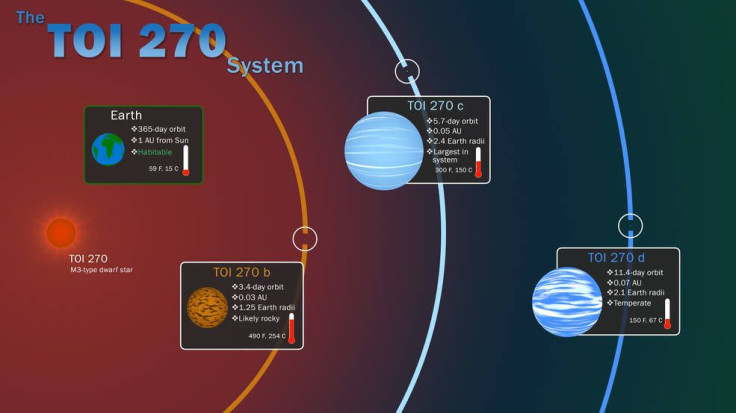NASA Discovers 3 New Worlds 73 Light-Years Away: Are They Potentially Habitable?

Scientists from NASA have discovered three new alien planets orbiting a distant host star. According to their discovery, one of the planets could be habitable due to its environmental condition.
Using the space agency’s Transiting Exoplanet Survey Satellite (TESS), scientists discovered a small system of planets and catalogued it into their TESS Object of Interest (TOI) program.
At the center of this system is an M3-type of dwarf star known as TOI 270. According to the scientists, the star is about 40 percent smaller than the Sun and is located about 73 light-years away. Orbiting around the star are three planets known as TOI 270 B, TOI 270 C and TOI 270 D.
The scientists noted that the conditions within these planets vary depending on their distance from TOI 270.
“This system is exactly what TESS was designed to find – small, temperate planets that pass or transit, in front of an inactive host star, one lacking excessive stellar activity, such as flares,” lead researcher Maximilian Gunther of the Massachusetts Institute of Technology said in a statement.
“This star is quiet and very close to us, and therefore much brighter than the host stars of comparable systems,” he added. “With extended follow-up observations, we’ll soon be able to determine the make-up of these worlds, establish if atmospheres are present and what gases they contain and more.”
The planet TOI 270 B orbits closest to the host star and is about 25% larger than Earth. Due to its close proximity to TOI 270, scientists believe it has oven-like conditions and has an equilibrium temperature of around 490 degrees Fahrenheit.
The other two planets are about twice as big as Earth. Of the two, the planet farthest from the star, known as TOI 270 D, has the lowest temperature. Scientists estimated that it has an equilibrium temperature of 150 degrees Fahrenheit.
Scientists believe that further studies on this planet will reveal more helpful information regarding its environmental conditions. These future observations could also reveal if the planet is habitable.
“TOI 270 is perfectly situated in the sky for studying the atmosphere of its outer planets with NASA’s future James Webb Space Telescope,” the study’s co-author Adina Feinstein of the University of Chicago said.
“It would be observable by Webb for over half a year, which could allow for really interesting comparison studies between the atmospheres of TOI 270 C and D,” she added.
The findings of the scientists were detailed in a new study published in Nature Astronomy.
© Copyright IBTimes 2024. All rights reserved.





















